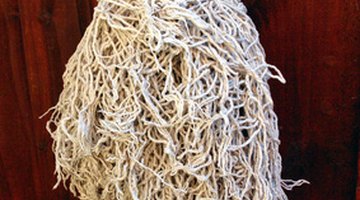How to Apply Polyurethane to Concrete Floors
Concrete floors are becoming more common in home construction and public buildings alike. To preserve the look of your concrete, especially if it stamped, etched or stained, you will need to apply a sealing agent. One of the easiest and most cost effective is polyurethane.

Once applied, maintenance is simple, and applying a new coat when needed will cover most problems. Using a lamb's wool applicator will help you avoid most common issues.
Things You Will Need
- Mineral spirits
- Mop
- Shoe covers or clean socks
- Polyurethane
- Lamb's wool applicator
-
Mop the floor with odorless mineral spirits. This solvent will evaporate quickly, drying the floor to prepare it for the polyurethane. Use a filtered mask and fans for ventilation to prevent discomfort from the minimal fumes of the mineral spirits.
-
Stir the polyurethane slowly, with a wooden paint paddle, until it is clear all the way to the bottom of the can. Do not shake. This will cause bubbles that can mar your finished product. Put shoe covers over your shoes, or work in clean socks.
-
Pour a small amount of polyurethane onto the floor beginning in one corner of the space. Work toward an exit, so that you don't paint yourself, literally, into a corner. Spread the polyurethane slowly and smoothly with a lamb's wool applicator, available from janitorial supply houses. Do not agitate the finish as it goes on. Overlap your strokes to get full coverage and keep a wet edge.
-
Pour more finish once you have spread the first amount thoroughly. Work along one wall parallel to the wall with the door you will be exiting. Work a row 6 to 8 feet wide from the wall. Work across to the adjoining wall. Start a new row, overlapping the first by 6 to 8 inches for adequate coverage.
-
Continue spreading slowly until the entire surface is coated. Do not step back over your work area. Allow the finish to set for the label-recommended drying time between coats. Do not use fans to speed the drying. Space heaters can be used; warmer air will speed the drying without the risk of bubbles.
-
Check the floor carefully to be certain it is dry to the touch before walking back out to apply the second coat. Start in the same place and apply the second coat using the same technique as the first. Work slowly to avoid bubbles and prevent puddling.
-
Apply three to four coats, allowing the finish to dry between each coat. Wait 24-hours before allowing foot traffic or furniture to be moved onto the floor.
The Drip Cap
- Concrete floors are becoming more common in home construction and public buildings alike.
- Mop the floor with odorless mineral spirits.
- This solvent will evaporate quickly, drying the floor to prepare it for the polyurethane.
- Spread the polyurethane slowly and smoothly with a lamb's wool applicator, available from janitorial supply houses.
- Work a row 6 to 8 feet wide from the wall.
- Do not use fans to speed the drying.
- Space heaters can be used; warmer air will speed the drying without the risk of bubbles.
References
- “Concrete Floor, Finishes, and External Paving”: Phillip Harold Perkins
- FinerLiving.net: Concrete Floor Sealer
Writer Bio
Mark Morris started writing professionally in 1995. He has published a novel and stage plays with SEEDS studio. Morris specializes in many topics and has 15 years of professional carpentry experience. He is a voice, acting and film teacher. He also teaches stage craft and lectures on playwriting for Oklahoma Christian University.
Photo Credits
- mop head image by green308 from Fotolia.com
- mop head image by green308 from Fotolia.com
More Articles



